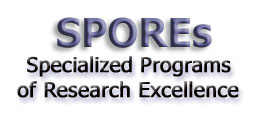|
[ SPOREs:
|
|
|
|
|
|
|
|
|
|
|
|
|
]
Skin SPOREs
Skin cancer is the most common form of cancer in the United States. The three major types of skin cancer are the highly curable basal cell carcinoma, squamous cell carcinomas and the more serious malignant melanoma. Exposure to the sun's ultraviolet (UV) rays appears to be the most important environmental factor involved in the development of skin cancer. Individuals at high risk for melanoma have also been identified, some of whom have been found to carry mutations in several cancer related genes. Over sixty-eight thousand individuals in the United States will be diagnosed with "malignant" skin cancer in 2005 (excludes basal and squamous cell carcinoma) and 10,710 individuals will die of this disease. Several recent discoveries within the melanoma field, including the frequent identification of B-RAF mutations in melanomas, molecular profiles associated with therapeutic response, and potential tumor stem cell markers, makes this an especially exciting time for translational research activities within this cancer site. The Skin Cancer SPORE program was initiated in 2001 with the funding of two SPOREs and has recently increased to three. These three programs are predominantly focused on melanoma research activities, but also include projects focused on the treatment of cutaneous T-cell lymphoma (CTCL). The translational activities for melanoma include the development of novel therapeutics (predominantly immunotherapies), characterization of risk and prognostic biomarkers, as well as the utilization of novel animal and cell culture models to test therapeutic or preventative agents.
To view the abstracts for the P50 SPOREs, please click on the name/address below.
|
Meenhard I. Herlyn, DVM
The Wistar Institute
3601 Spruce Street
Philadelphia, PA 19104
Tel: (215) 898-3950
Fax: (215) 898-0980
For more information on this specific SPORE's institution, please visit: http://www.wistar.org/ways_of_giving/briefs.htm
|
Ruth Halaban, PhD
Senior Research Scientist
Yale University School of Medicine
Department of Dermatology
P.O. Box: 208059
15 York St., HRT 610
New Haven, CT 06520-8059
Tel: 203-785-4352
Fax: 203-785-7637
|
Elizabeth A. Grimm, Ph.D.
Co-Director, Melanoma Research Program
Professor, Department of Bioimmunotherapy, Unit 362
University of Texas, M.D. Anderson Cancer Center
Houston, TX 77030
Tel: (713) 792-3667
Fax: (713) 792-2070
For more information on this specific SPORE's institution, please visit: http://www.mdanderson.org/Departments/melanomaspore/
|
Thomas S. Kupper, M.D.
Chairman, Department of Dermatology
Brigham and Women's Hospital
77 Louis Pasteur Avenue, HIM 671
Boston, MA 02115
Tel: (617) 525-5550
Fax: (617) 525-5571
For more information on this specific SPORE’s institution, please visit: http://www.dfhcc.harvard.edu/spores/skin/ |
|











